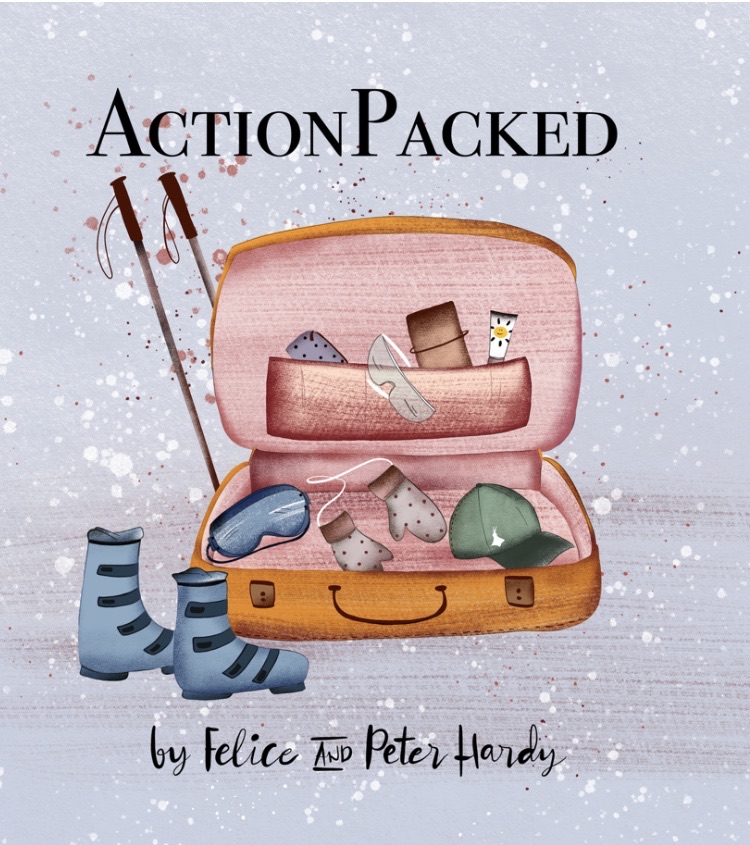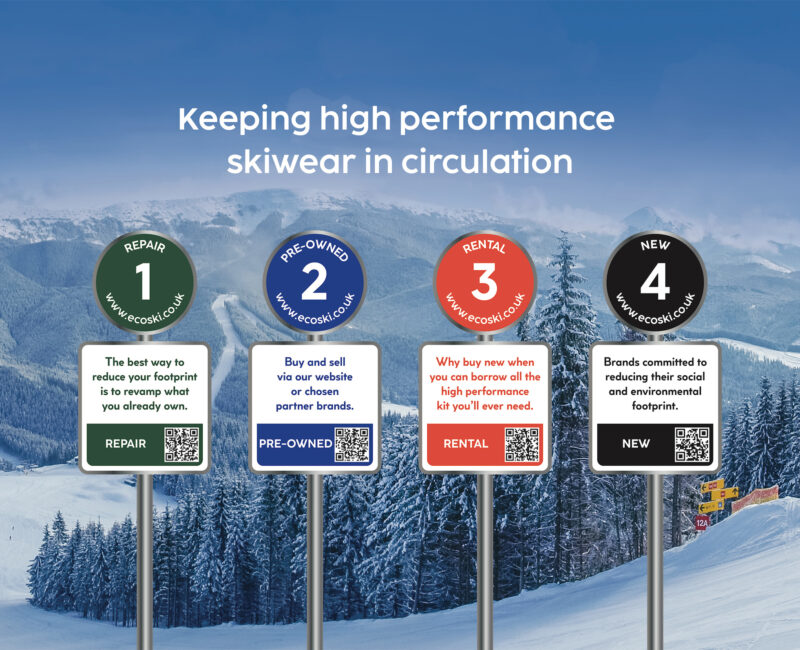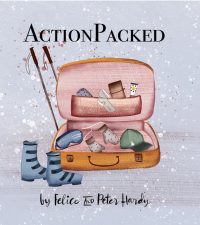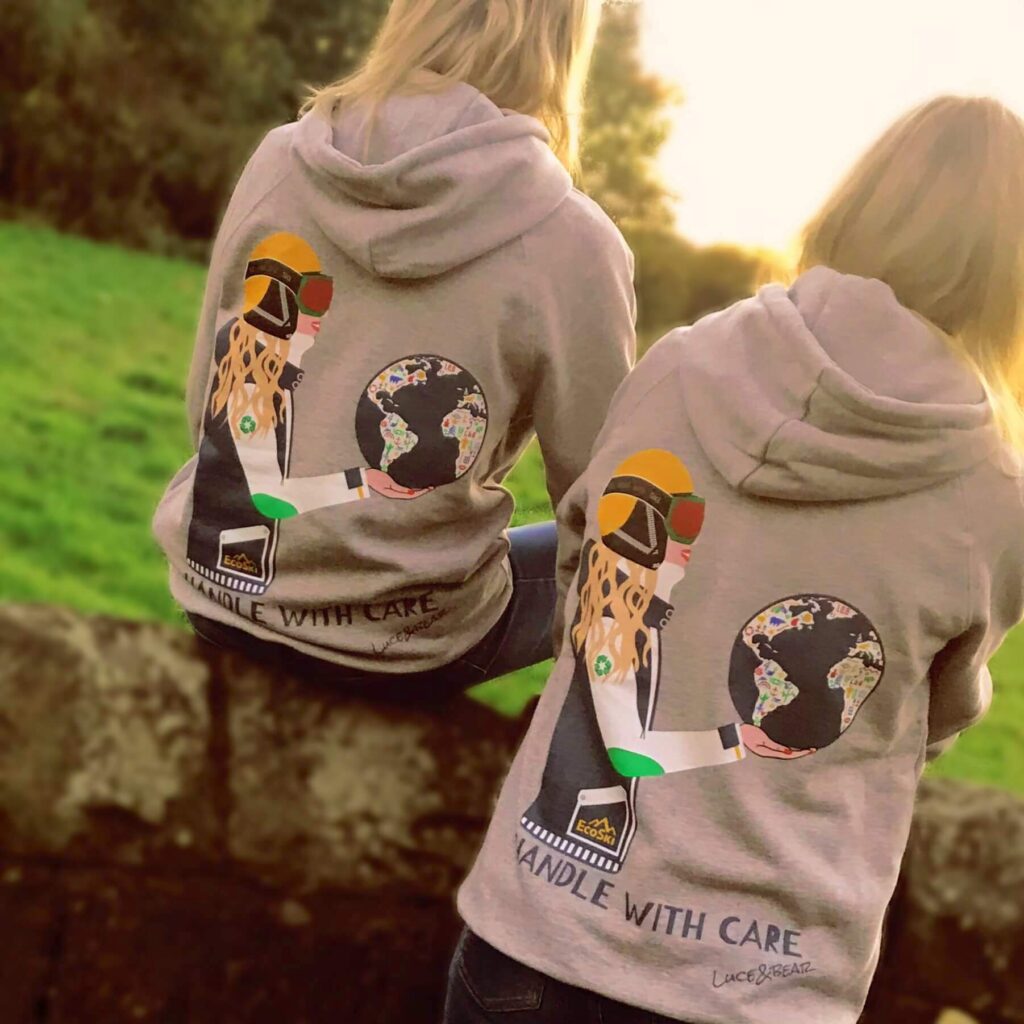
Photo: © EcoSki
Peter You wake up, jump out of bed, pull back the curtains and wow, you just can’t believe your eyes. This is what I’ve been yearning for during all this interminable time.
Felice I just can’t remember being this excited.
Peter You’ve guessed it, after 22 months away from the mountains and snow, Felice and I are finally going skiing. We’re heading off to beautiful little Andermatt in Switzerland, which is already open for glacier skiing on the mighty 3000-metre Gemstock, a classic mountain. It’s reached by a two-stage cable-car.
Felice We can’t wait! To prepare ourselves for some of the changes in skiing brought about by the pandemic and climate change, we decided to have a chat with Rachael Westbrook, founder of EcoSki, which is what it says on the tin, a company that is trying to change our whole approach to what we wear on snow.
**********
Peter Welcome to our travel podcast. We’re specialist travel writers and we’ve spent half a lifetime exploring every corner of the world.
Felice So we want to share with you some of our extraordinary experiences and the amazing people we’ve met along the way.
Peter Rachael Westbrook, thank you very much for coming on the show.
Rachael Thank you so much for having me. It’s an honour.
Peter Now we’re going skiing very shortly. We’re back to skiing. Personally, I haven’t…nor has Felice…been skiing for nearly two years.
Felice We last went in January 2020.
Peter That is a long time. But we’re off to Andermatt in Switzerland and it’s really exciting. Can’t wait to get back on snow again. But in our two-year absence from the snow, like for everybody, things have changed. We’re now really thinking about the environment in which we’re going to ski. Rachael, we’re off skiing. Should I be rushing out and buying myself a whole new ski kit ready to go for my trip to Andermatt?
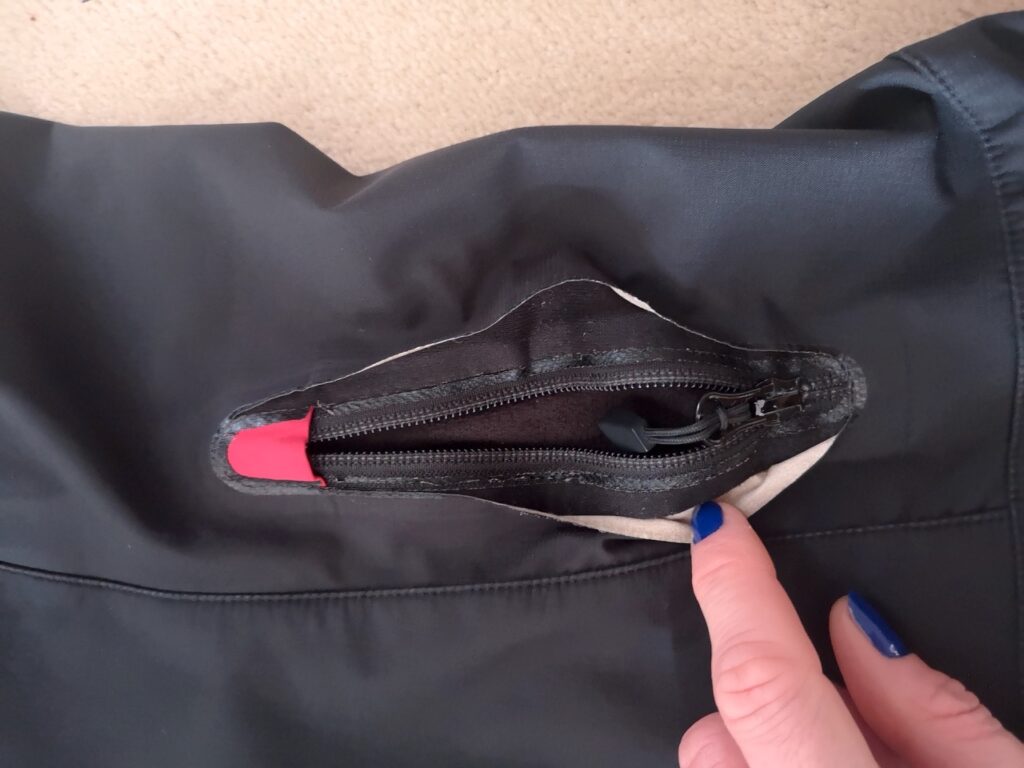
Ski suit repairs. Photo: © EcoSki
Rachael Well, I think if you’ve got a perfectly good kit already, no, because the most sustainable item of clothing that you can possibly own is what you already have. I don’t know whether I’ve explained to you before about the four pistes? So we’ve got a green run, a blue run, a red run and a black run. And the green run, which is the most sustainable thing you can do, is repair what you already own – or wear what you already own. We have a repair service and we’ve partnered up with two repair companies that can do all of the repair on your behalf.
The blue run is pre-owned, so we have a small pre-owned section at the moment. We’ve only started, so it’s not massive. Then the next option is the red run, which is rent. Then the black run – which is not saying it’s bad, because the black run is the best run to do – is buying new. But if you do buy new, buy better and keep it for life and it’s really just that different pistes suit different skiers.
For you guys that ski a lot, there’s nothing wrong with buying new because that’s probably going to reduce your footprint. If you’re renting kit every week, the transportation there and back and cleaning and sterilising and everything at the other end, you’re better off just having it at home and spot cleaning it, popping it away, taking it back out. That’s the best thing you can do. You’ve just got to make sure you look after that kit and wear it and wear it and wear it, repair it, get it fixed. So by better buy new.
If you’re not skiing all the time, consider rental, which is the new platform that we’ve just launched, which is perfect for families, growing families especially. The pre-owned. There’s nothing wrong with pre-owned kit. I think people kind of have this stigma attached, thinking that it’s like second hand, second quality, but that’s not the case at all. I think we’re all changing shapes and sizes. And, you know, quite often we buy top of the range kit two years ago and then can’t do the zip up. So it kind of has to go somewhere. So, yes, and then just repair. So no, Peter, if you’ve got a good outfit, stick with it.
Peter Well, I have to say my favourite jacket is a black one. I can’t actually remember who the manufacturer is because I’ve had it for so long. I’ve maybe skis on it for two or 300 days. And it’s really, really warm, really technical. And I tend to wear that mostly, and then I can change the pants so that you have a different colour schemes, whatever.
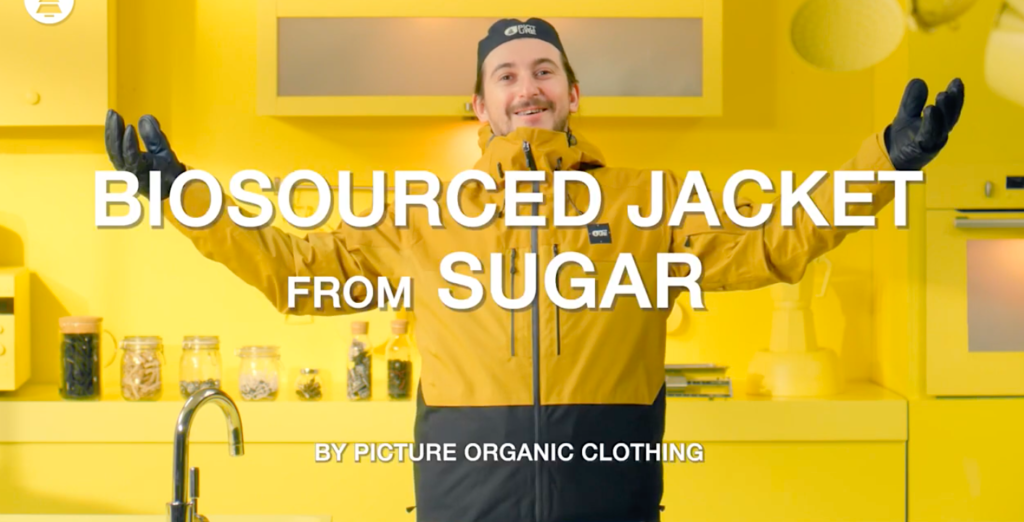
Picture Organic Clothing uses sugar in makes ski jackets
Rachael Exactly, just switching your pants around. And if you did just fancy a change, you can give us your old pants and we can sell them on your behalf. But yes, it’s all about keeping kit in circulation. There’s some incredible innovations happening with the brands at the moment. Picture Organic, for example, 60% of their range this season is bio sourced, so they’re moving away from their dependency on fossil fuel, derived fibres, which is fantastic. And then when it comes to mid layers, you know, regenerative organic cotton or regenerative wool, which means that you’re giving back to the planet at the same time, so you’re replenishing the soil and soil’s obviously a massive carbon capture.
We just need to just start looking after, not taking so much and giving back. So that’s why we’re pushing those brands. But also at the same time, even if these brands are making stuff out of 100% bio sourced fabric, it’s still coming at a cost to the planet – the air miles, the factory. So you don’t want to be buying that new and then saying, ‘Oh, it’s a sustainable jacket by 100% bio sourced,’ and then putting it in the loft and then buying another one next year. That’s what we’re trying to avoid. So we’re promoting the better, more responsible techniques and brands and ranges but we’re encouraging skiers to keep it in circulation. So if you do buy new, then you can give it back to us and we can sell it pre-loved, keep it in circulation. Or buy new and just keep wearing it, just like Peter does.
Felice During lockdown, some of the pictures I saw online of dolphins swimming into the Grand Canal in Venice for the first time ever and all sorts of wildlife taking over cities because there were no cars around and hardly any people, it was amazing to see. At the time, I really wished that it would stay like that, but of course it doesn’t. But I think people have been made more aware of the environment, perhaps, because of that sort of thing.
Rachael I agree. So when I first dreamt up EcoSki…it was gosh, how long ago? Three or four years ago now I’d say, and just prior to COVID I remember being at a dinner party and people were asking about EcoSki and I was saying: ‘Trying to bring the more responsible brands altogether and trying to keep it in circulation.’
And even my husband, he’ll kill me for telling you this especially when it’s on a podcast, but he kept saying: ‘No one’s interested in the environment and nobody’s interested in what material that jacket’s made out of.’ And he kept saying ‘It’s all really top quality kit.’ But suddenly, since that conversation pre-COVID, it’s everybody’s first question is: ‘How can I reduce my impact? What’s my ski kit made up of, like the ingredients in it?’ People are genuinely interested.

EcoSki stand at a ski show.
So COVID in some ways has been good for EcoSki from a business perspective. Also good that people are now opening their eyes. And I’m very much learning as I go along and I’m very open and honest. I’d love to just have answers to everything and say you need to do X, Y and Z, and this is going to reduce your impact by whatever. When it comes to clothing, you can’t. It’s like comparing apples with pears. And then there’s so much other things to consider; it’s not just the actual material that’s gone into it – it’s the labour, it’s the dying, it’s the air miles, it’s the transport, how the factories operated, what renewable energy, the waste. You get stuck down these rabbit warrens – and the traceability, transparency. The sustainability journey for me is being massive and I’m still learning every day. But I love it.
Felice I looked at your website and I thought that the prices for rental are really good. I mean, for someone who only skis a week a year and doesn’t want to keep the same jacket year after year, it would cost them just a few pounds a day to rent a jacket, for example.
Rachael Well, yes, exactly.
Felice After a week, you’ve maybe spent £40 or £50 on your jacket.
Rachael For children I think if they get a jacket, pants, you’re looking at just over £100 for the week. We’ve tried to make it as affordable as possible to try and get people to consider rental and then once it’s in their psyche and they’re happy to do it, we have no intention of upping our prices. But it’s really just to encourage people to consider it and especially the younger generation, the teenagers, you know, especially with social media and Instagram, they all want to look different.
For me, every year that goes by, you’re wearing the same jackets like, ‘Oh, what year was that?’ You’ll probably have the same same problem, Peter. My parents, in my family photos as a child, my dad is wearing the same outfit, every single photo, so we can just tell by his moustache what year it was.

Peter Well, because of our job, we can recognise clothing from year to year. We nudge each other on the mountain: ‘Look at that. Have you ever seen a 1989 jacket like that? They don’t make that anymore.’ We spent years filming ski clothing, so we knew the date of each model, if you like.
Rachael Oh, incredible. But yes, the rental, the pricing is very attractive. I think for the kind of teenagers out there, their change of outfits, it’s going to suit them …you know, as opposed to us just hammering home about sustainability and ‘we have to do this and you have to do that ‘and telling people that they’re doing things wrong and saying that you can’t buy that outfit and you can’t do that. It’s just people don’t like to be told what they can’t do.
So I think it’s providing solutions for people so they can continue to do what they love, but do it cost-effectively and a bit more environmentally friendly. So not over-consuming, not buying this kind of ski kit that you can buy in Lidl…not badmouthing Lidl, but they’re not ski wear experts so it’s not going to be the best kit. So you want to be buying better, but we want to make it more affordable to people that perhaps are skiing once or twice a year.
Felice You offer repairs which is really good, because most people wouldn’t know how to repair ski clothing. And what sort of repairs would you do?
Rachael Well, ski clothing repairs are quite technical, obviously with the taped seams and the waterproofing and things like that. So we have a repairs partner, a local one to us that can do general patching up and seams on your base layers and mid layers and even your mid-laters they’ll kind of patch up. But for the more technical stuff we’re using Lancashire Sports Repairs, I don’t know whether you know them, but they’re up in Cumbria and they do all of the warranty repairs on behalf of…they just taken on Patagonia‘s work over in the UK…and they do Mammut. I think they do Haglofs, Marmot. They’ve got all the right equipment that Gore-Tex have given them, so they get all the temperatures correct. So we just know that the kit is going to be repaired properly and our rental partners up at ACS Clothing, they’ve got a really incredible repairs service as well.

Rachael, left, with Chemmy. Photo: © Ecoski
Did you watch Ski Sunday? I bet you did last year. So Chemmy Alcott is our ambassador, and she presented wearing our kit that we then put into auction. So another part of the whole EcoSki DNA is giving back to environmental charities – so using the business as a means of giving back and supporting environmental charities. So she wore her outfits and then we put them into auction and then 100% of the money that was raised went to the charities that we’re supporting. She had ripped a pair of her pants, I think, on a tree. You don’t see many trees in downhill skiing, really, I don’t know what she was doing. Anyway ACS guys fixed that so they can do a lot of repairs as well.
So our rental kit will be repaired by them and we expect a bit of coffee and wine and it’s going to get marked. But these guys are specialist cleaners; if they can’t get the stains out, nobody will. So the repairing is a big part, the cleaning is a big part and the sterilising is a big part. So they put it through this ozone chamber that kills – it’s like hospital grade kit. So actually the rental kit that you receive will be cleaner than buying it new because nobody’s touched it, which is brilliant. So especially in the COVID world, it works.
Peter I guess finally, if you have an old fleece or several old fleeces that are completely exhausted and really unusable, you can always send them on to Switzerland, where they’re using mile upon mile of fleece material to cover the glacier during the summer months and keeping the snow. And now at the beginning of the season, people are skiing on two-year-old snow. When they go up the mountain at the very beginning of the season, the base layer is two years old, which is quite remarkable. It’s all thanks to recycling fleeces.
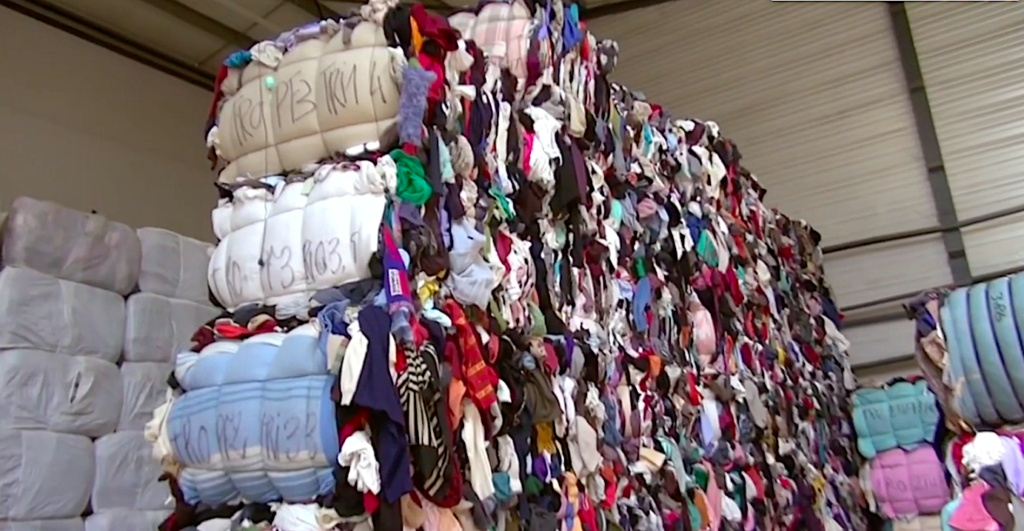
Recycling clothing at ACS
Rachael Well, that’s a good; we should partner up with them. We’ve partnered with an end-of-life recycling company over here in the UK and the way that they work and their recycling is on a pyramid system. So tier one is fibre to fibre. So they shred it and it comes out as fibre and then it’s reused into clothing. Tier two goes into insulation for building materials and insulation for dog beds and things like that.
With our ski jackets, for example, most of them are plastic-based and plastic, when it comes to recycling, you can’t keep recycling plastic. It’s not like glass and aluminium that you can recycle and recycle and recycle. The plastics a bit harder because it loses its strength and dexterity. And then the third tier is made into bio pellets for fuel. So we have kit under our watch, on our rental platform, or if Peter sends something back that we can’t repair, then it will go to the recycling guys.

The key is really just to send zero to landfill. There’s too much waste; we’ve all been operating on it, this linear economy we take, we make what we want and then we discarded it and we really need to just start taking less giving back to the planet what we take and keeping what we do take in circulation for as long as possible. That’s what we’re trying to achieve with EcoSki, making it easier for people, providing a solution for them, but making it cost-effective as well and just learning together, partnering with.
I think it’s just this mind set shift for all of us, isn’t it? As skiers, you know, skiing is not an environmentally-friendly sport. If I really was going to hugely reduce my impact, I wouldn’t go skiing in the first place. But, you know, without skiing…oh, life’s for living at the same time, we just need to find better ways of doing it. And there’s so many things that we can do. You know, choosing the right resorts, choosing the right hotels, eating locally-produced food, wearing the right kit, not wasting.
Peter The amount of waste material that’s picked up off the mountain each summer is really quite appalling.
Rachael Yes.
Peter I’m glad it’s done, but it’s tons and tons and tons of discarded objects from picnics and people dropping things off chair-lifts and everything. It’s just a remarkable amount of stuff that’s found each year.
Rachael I know, and it’s all run by volunteers doing the clean-ups in the results, isn’t it? Because when I was looking at the charity aspect of trying to partner with people, that was something that we wanted to be able to support: the clean ups. But it’s very resort specific and we haven’t partnered with a clean-up, but yes, I mean, just the sheer volume of waste there is eye watering, isn’t it?
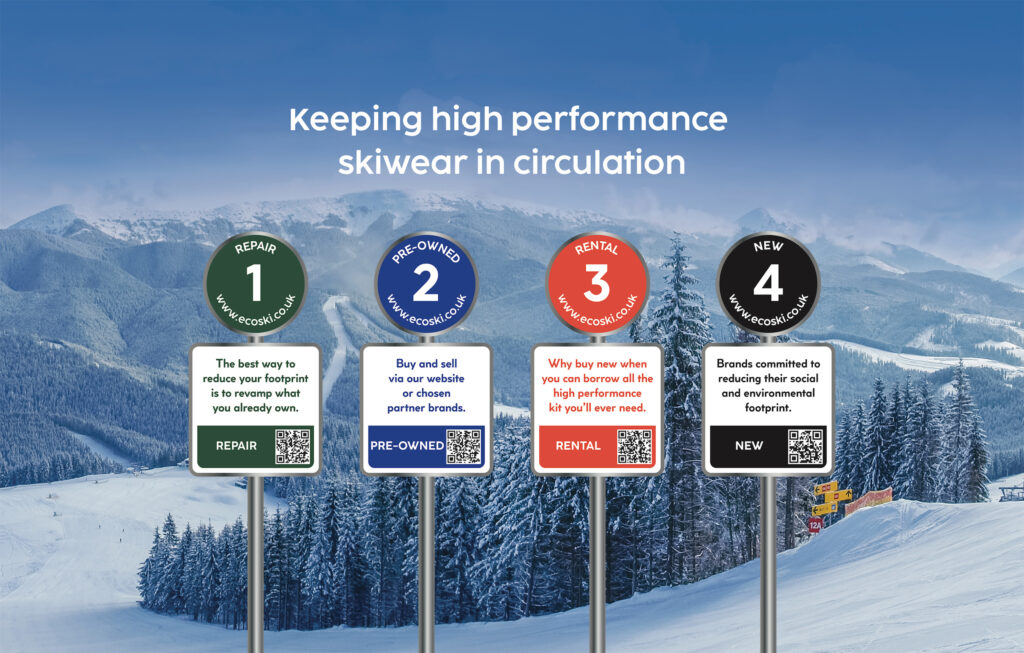
Photo: © EcoSki
Felice And you have an eco glossary? What is that exactly?
Rachael We do have an eco glossary, so that was my way on my journey with EcoSki of coming across all this different terminology, all the things to look out for, the meaning of everything. So I just started collating it all on in a notebook and then I thought, you know, I’ll just start putting it on the website. So slowly but surely we’re adding’ it just seems to get longer and longer and longer. But it’s just a glossary, that it’s my interpretation. So if anybody reads it and says it’s got it wrong, then let me know and we can amend it. But I think it’s correct.
There’s a lot to consider, like all the different accreditations for all the different fabrics and the more environmentally ways of operating the factory and producing the clothing, trying to reduce the footprint, the waste, the materials used, the dyes used. There’s just so much to consider. So it’s all in the glossary – you can probably get lost in there.
Felice People want to find out more about you. How do they do that?
Rachael Well, we are on all the social media channels, so we’re on Twitter, we’re on Instagram, Facebook, LinkedIn. Gosh, where else? And obviously our website, www.ecoskico.uk – it’s quite easy to remember. But yes, I mean, just kind of like supporting and any questions. We’re very much here for people to ask, and if we don’t know the answer we’ll find out or we’ll find the right person to answer that. We see it very much as a learning platform for us all to learn together.
Peter Rachael Westbrook, thank you very much indeed for appearing on the show and we wish you the very best of luck with EcoSki in the future.
Rachael Well, thank you so much for having me, it’s been a pleasure. I could talk all day, but we must stop.
Peter We must stop because we have to go skiing.
Rachael Yes, you do. Quick, go pack your black jacket.

Felice That’s all for now. If you’ve enjoyed the show, please share this episode with at least one other person! Do also subscribe on Spotify, i-Tunes or any of the many podcast providers – where you can give us a rating. You can subscribe on Spotify, Apple Podcasts or any of the many podcast platforms. You can also find us on Twitter, Facebook and Instagram. We’d love you to sign up for our regular emails to [email protected]. And by the way, we just like to mention that if you take up our special offer to buy Water To Go bottles, we do earn a small commission; this helps with the production costs of the podcast. Until next week, stay safe.
Also see our episode What You Should Know About Water-To-Go.
© ActionPacked Travel

- Join over a hundred thousand podcasters already using Buzzsprout to get their message out to the world.
- Following the link lets Buzzsprout know we sent you, gets you a $20 Amazon gift card if you sign up for a paid plan, and helps support our show.
